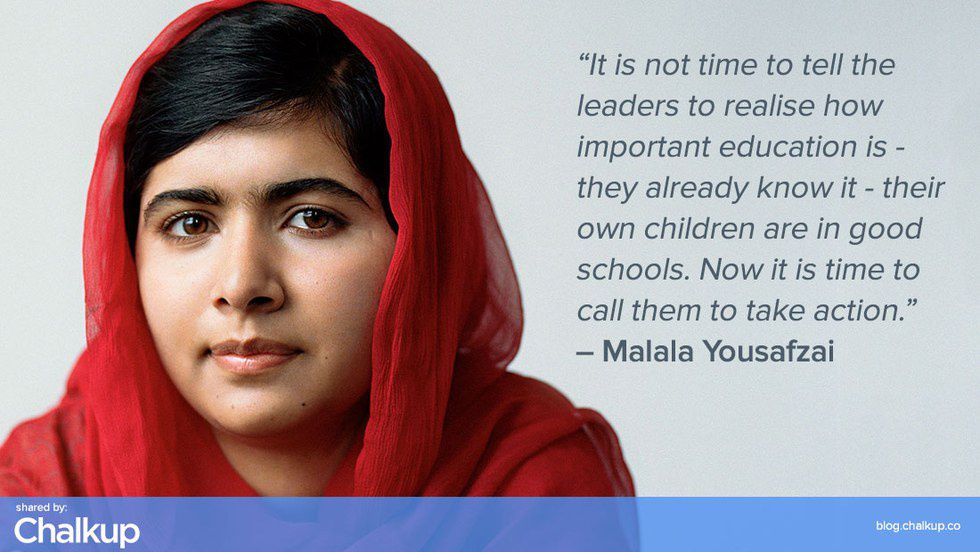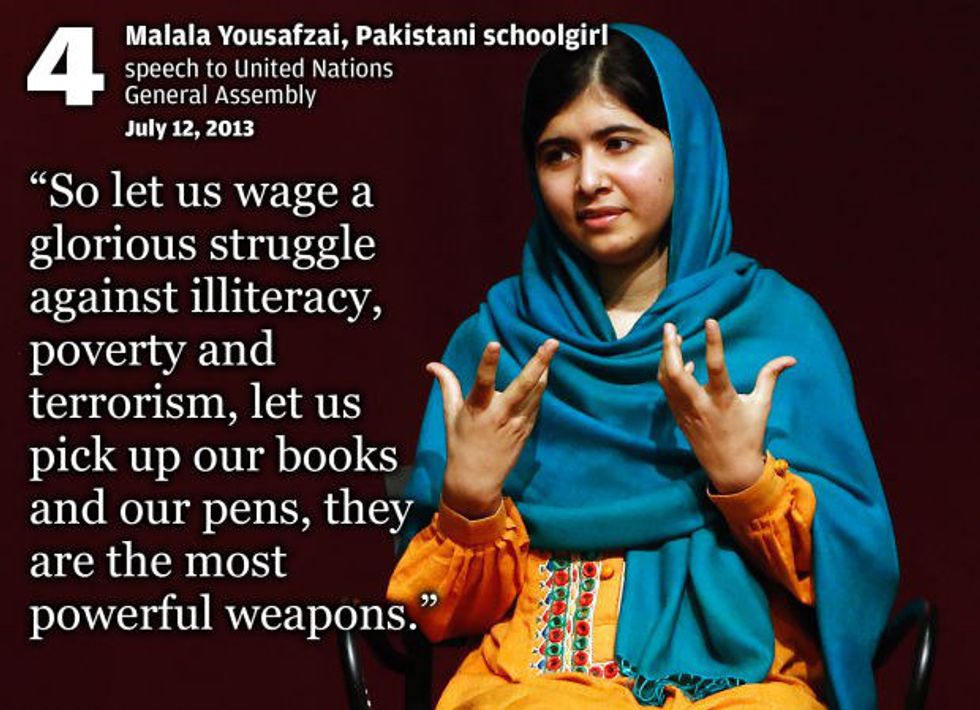I picked a photo of my high school graduation as the cover photo for this article because I view it as one of many peaks in my own educational journey. However, as we all know, a high school diploma is not guaranteed. And especially for women, the journey to receive any type of education is laden with countless obstacles along the way. Women's education, and the lack of accessibility of it, has caused problems more than most of us can see. Women's health is declining, poverty rates increasing and lives are being lost-- due to the oppressive nature of communities around the world that marginalize women and fail to grant them their rights as human beings. Take Malala, for example, a Pakistani schoolgirl who was shot in the head on her way to school. She was powerful, intelligent, and a threat to the Taliban. Now, in the aftermath of one nearly fatal school day, she resides in Europe as the youngest Nobel Peace Prize winner, still aiming to earn young girls the rights to their education. Here are the facts you need to know in order to understand why women's right to education is worth fighting for.
Currently 62 million girls around the world are not in school. Half of them are adolescents.
Numerous reasons could explain why a young woman is not in school. All too often, a family cannot offer the financial resources for the women in their families to go to school. In some situations, a family might only be able to pay for one child in the family, and that child is usually a boy. Sometimes, the girl might be in school until she is married or becomes pregnant, and then can no longer attend. And even in places where public education is free, the cost for the mandatory uniforms and school supplies will stop the student from being able to attend. Beyond that, sometimes the school is too far away, and the transportation too dangerous for women to ride. And then, even deeper than these reasons lies the idea that some countries simply don't consider a woman deserving enough of an education.
In 2015, out of the 163 million illiterate youth in the world, over 63 percent of the youth were female.
That's far more than half. And young boys and girls who are attending school can still fall under this number. Girls who only have one or two years of an education could still be illiterate. So, even when the problem isn't access to education, the problem could be the continued ability to attend school, or the quality of the education itself. This could stem from lack of financial resources in the nation to provide a proper education system. In some countries, public school isn't regularly attended by teachers. And then, on top of that, the teachers that irregularly attend school are not guaranteed to be well-educated themselves. So, not only do we need women to have access to school itself, we need to start working on what the students are learning once they actually enter school.
Their absence in schools causes them to be more susceptible to HIV/AIDS, early or forced marriage, and different kinds of physical violence.
According to the United Nations, young women are most vulnerable for human trafficking when they are uneducated and poor. But, a girl who completes a primary education is three times less likely to contract HIV/AIDS. When women do receive an education, their life improves overall. They are statistically less likely to marry young, give birth sooner (which increases their life span), and then their children are then more likely to attend school. Yes, a woman's physical health improves when her rights to an education are valued.
When a girl does receive a proper education, she is more likely to earn a decent living, and improve the quality of life for herself, her family, and her community.
A World Bank study found that every year of a woman's secondary education is correlated with an 18 percent increase in a girl's future earning power. And according to the Borgen Project, national GDP increases when boys and girls have equal access to education. Beyond the improvement of physical health, there are so many positive benefits of valuing this fundamental human right.
What People Are Doing to Fix This:
Let Girls Learn Initiative:
The Obama's recently launched a girls' global education initiative that recognizes not only the economic barriers preventing young girls from attending school, but also the attitudes and beliefs of oppressive systems that marginalize women. Teaming up with the Peace Corps, thousands of volunteers will be coming together to create girls' leadership camps, mentoring programs, and a lot more to help young women achieve the empowerment to believe that they can accomplish great things with education.
The United Nation's Women's Education Initiative:
Not only does the UN offer an incredible infographic that educates us about the importance of women's education, the United Nations proposed a goal to have every child in the world in school by 2030. With their Global Partnership for Education, 31 of their partner countries have achieved gender parity in primary school completion.
An organization that sits near and dear to my heart. $360 of donations can sponsor one of their students in Ecuador for an entire year. And, not only do they help young girls and boys attend school, they offer free after-school programs and tutors to the students. The sponsorship money helps a student to afford the ridiculously expensive school uniforms and supplies mandatory to attend school in Ecuador. If you really want to get involved, they have incredible programs in which you work in the after school programs in Ecuador as a volunteer, experience the culture of Ecuador, and fall in love with the energy of the Starfish students.
This company sells handmade jewelry, made by inner-city youth, with 100% of profits helping economically disadvantaged youth recognize their true potential by helping them achieve a higher education. Not only is the jewelry adorable, it has an awesome message. While specifically focused on American students, it helps young men and women alike, most of them first-generation college students, reach their dreams.
Women for Women International:
This organization provides women with a year-long training that teaches them business and life skills for the goal of social and economic empowerment of women in war-torn areas like Afghanistan, Iraq, and South Sudan. These grown women receive a monthly stipend so they are able to attend the program. After two years of training, the women report a five fold increase in their income. For $35/month, you can sponsor a sister to receive this incredible education.
What To Read:
I am Malala, by Malala Yousafzai
Behind the Beautiful Forevers, by Katherine Boo
Sources:
http://borgenproject.org/top-10-reasons-female-edu...
https://www.whitehouse.gov/letgirlslearn




















